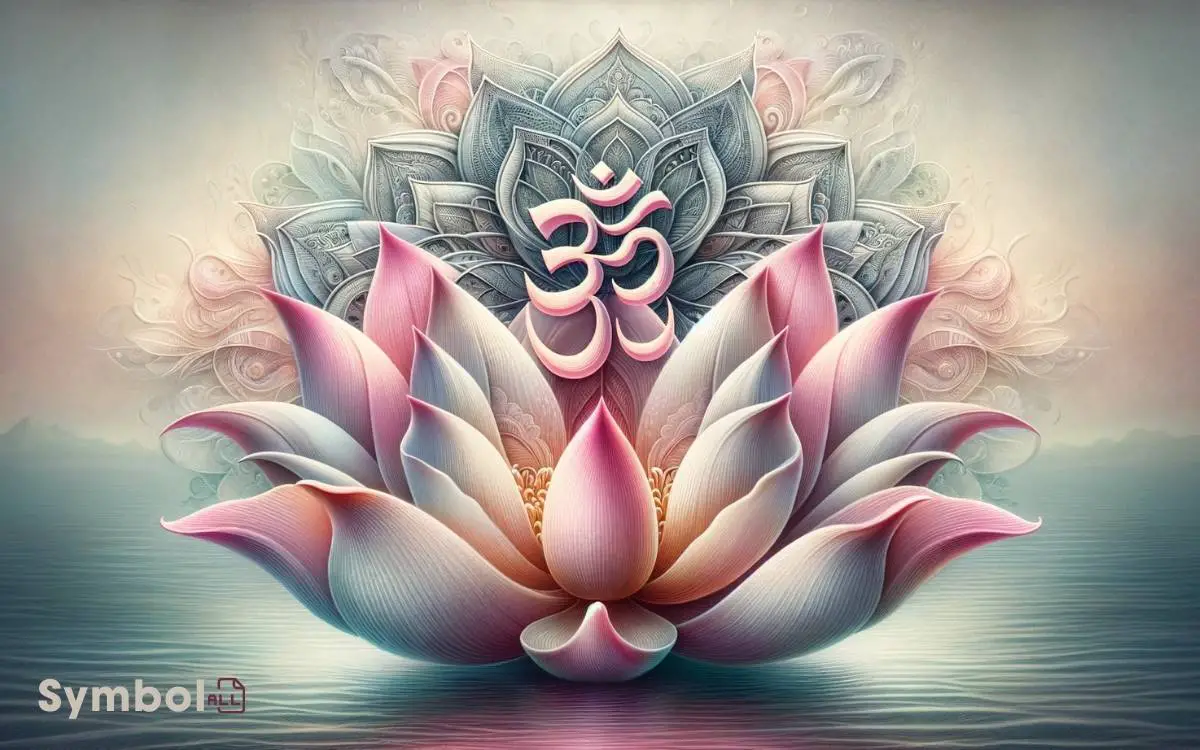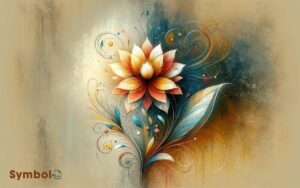Lotus Flower and Om Symbol: Purity, Enlightenment!
You’re exploring symbols packed with meaning: the Lotus Flower and the Om symbol. Steeped in ancient history, the Lotus stands for purity, enlightenment, and rebirth, thriving in adversity to symbolize untarnished purity.
It’s sacred across Eastern religions, embodying spiritual awakening. Meanwhile, Om represents the essence of the universe, a vital sound bridging the physical and spiritual. It’s vital in meditation, enhancing focus and spiritual awareness.
Together, they reflect a journey of enlightenment and the cyclical nature of existence. Their interconnection in art, yoga, and rituals brings profound insights into life’s interconnectedness, inviting you to uncover deeper layers of understanding.

Key Takeaways
Origins of the Lotus Flower
The Lotus Flower, deeply rooted in ancient civilizations, symbolizes purity and enlightenment across various cultures. As you explore its origins, you’ll discover the lotus’s significance transcends mere aesthetic appeal.
Ancient Egyptians revered it for its ability to emerge from murky waters, unscathed and beautiful, seeing it as a symbol of rebirth and the sun.
Similarly, in Hinduism and Buddhism, the lotus represents spiritual awakening and purity of the body, mind, and soul. Its growth, from the mud to the surface, mirrors the journey of the soul from the material world to spiritual enlightenment.
This flower’s enduring presence in religious texts, artifacts, and temples underscores its profound impact on human thought and spirituality. It’s a confirmation of the human quest for meaning and transcendence.
Symbolism of the Lotus
You’ll find that the lotus flower isn’t just a plant; it’s a powerful symbol of spiritual rebirth and purity amidst adversity across various cultures. Its ability to emerge pristine from murky waters offers a poignant metaphor for overcoming difficulties.
This symbolism resonates deeply in religious and philosophical teachings, where it represents the purity of body, speech, and mind.
Spiritual Rebirth Significance
In various spiritual traditions, the lotus symbolizes rebirth and the profound ability to rise from adversity, offering a poignant reflection on the resilience of the human spirit.
This flower emerges from murky waters, unfurling its petals in the light, a powerful expression to overcoming darkness. It’s a journey that mirrors human experiences of growth through hardship, embodying spiritual awakening and renewal.
| Stage | Significance | Reflection |
|---|---|---|
| Bud emergence | Initial awakening | Potential and purity |
| Rising above | Overcoming adversity | Strength and determination |
| Bloom | Attainment of enlightenment | Ultimate realization and rebirth |
This imagery serves as a metaphor for the human condition, urging you to contemplate life’s cyclical nature and the inherent potential for transformation and enlightenment within us all.
Purity Amidst Adversity
Often, amidst life’s inevitable adversities, the lotus symbolizes the untarnished purity that can emerge from challenging circumstances.
You see, the lotus flower’s journey is emblematic of resilience and purity; it begins submerged in murky, muddy waters, only to rise and bloom immaculately above the surface.
This process, viewed through an ethnographic lens, mirrors the human condition. In cultures that revere the lotus, such as in India and Egypt, this flower embodies the purity of heart and mind, steadfast in the face of corruption or distraction.
It’s a powerful reminder that you, too, can maintain integrity and beauty in difficult times. The symbolism isn’t just poetic; it’s a lived ethos, encouraging a life of dignity and grace, no matter the environment.
Lotus in Various Cultures
You’ll find that the lotus holds a sacred place not only in Eastern religions but also resonates across various cultures worldwide. Its symbolism, deeply rooted in purity, enlightenment, and rebirth, reflects universal themes that transcend geographical boundaries.
This cultural interconnectivity invites a closer examination of how the lotus flower’s significance is both shared and uniquely interpreted across different societies.
Lotus in Eastern Religions
The lotus flower holds profound symbolic significance across various Eastern religions, embodying themes of purity, enlightenment, and rebirth.
In these traditions, the lotus’s journey from murky waters to bloom mirrors the spiritual progression towards enlightenment.
Analyzing its presence, you’ll uncover a rich tapestry of belief and practice:
- In Buddhism, the lotus represents purity of the body, speech, and mind, as it blooms unsullied by the mud below.
- Hinduism sees the lotus as a symbol of beauty, prosperity, and fertility, with gods often depicted seated on lotus thrones.
- In Jainism, the lotus signifies the essence of non-attachment, symbolizing souls rising above attachment to worldly matters.
This multifaceted symbol transcends mere floral representation, encapsulating profound spiritual teachings and ethical paradigms within these cultures.
Lotus Symbolism Worldwide
Across cultures, the lotus flower emerges as a universal symbol, embodying themes of purity, spiritual awakening, and the triumph of spirit over matter.
In your exploration of this symbol, you’ll find that it’s not just confined to Eastern religions. For instance, ancient Egyptian civilization revered the lotus for its ability to emerge from the murky waters pristine and beautiful, seeing it as a representation of rebirth and the sun.
Similarly, in Western cultures, the lotus has been embraced in contemporary spiritual practices, symbolizing personal growth and the journey towards enlightenment.
Each culture interprets the lotus through its unique lens, yet the core symbolism of purity, enlightenment, and resilience transcends geographical boundaries, making the lotus a truly global emblem of spiritual and personal transcendence.
Spiritual Significance of Lotus
Exploring the spiritual significance of the lotus, it’s clear that this flower embodies purity, enlightenment, and rebirth in various cultural contexts.
The lotus thrives in muddy waters, yet blooms untainted, symbolizing the human journey of rising above adversity towards spiritual awakening. This metaphor is deeply ingrained in the ethos of several Eastern religions and philosophies.
- Purity: Despite its roots in murky waters, the lotus remains clean, representing the purity of heart and mind.
- Enlightenment: As the lotus reaches for the light, it mirrors the soul’s quest for enlightenment.
- Rebirth: The lifecycle of the lotus, from seed to blossom, signifies the endless cycle of rebirth and spiritual renewal.
Analyzing these aspects, it’s evident that the lotus transcends mere floral beauty, embodying profound spiritual lessons and aspirations.
The Om Symbol Explained
Similarly, the Om symbol holds deep spiritual significance, serving as a sacred sound that encapsulates the essence of the universe in Hinduism and other Eastern traditions.
When you explore its layers, you uncover a rich tapestry of meaning, each curve and line resonating with philosophical depth.
The visual representation, often a complex, stylized script, isn’t just an icon; it’s a metaphysical map guiding seekers towards understanding the interconnectedness of existence.
Its utterance merges the physical with the spiritual, creating a vibrational bridge that connects individual consciousness to the cosmic.
This isn’t merely a symbol; it’s a tool, a sonic key revealing layers of the cosmos, reminding you that everything in the universe, from the smallest particle to the vast expanse of space, is interwoven with the sacred sound of Om.
Om in Ancient Texts
The Om symbol’s roots stretch deep into ancient scriptures, where its presence weaves through texts as both a sacred sound and a profound spiritual concept.
You’ll find its significance across:
- The Upanishads: These philosophical texts elaborate on the essence of Om, linking it to the ultimate reality and the cosmos.
- The Bhagavad Gita: Here, Om symbolizes the universe’s essence, underscoring its role in meditation and spiritual practices.
- The Vedas: As the oldest layer of Sanskrit literature, they introduce Om as a cosmic sound that pervades the universe.
Understanding Om’s presence in these texts offers insights into its timeless appeal and profound meaning. It’s not just a symbol but a bridge connecting the material to the spiritual, the individual to the universal.
The Vibrational Power of Om
Delving into Om’s essence, you’ll discover its unique vibrational power, believed to resonate through every aspect of the universe and connect deeply with human consciousness.
This primordial sound embodies the essence of the universe, creating a bridge between the tangible and the intangible.
| Aspect | Significance |
|---|---|
| Universal Resonance | Connects all existence |
| Deep Connection | Links individual and universal consciousness |
| Vibrational Impact | Influences mental and physical well-being |
Analyzing Om from an ethnographic standpoint, its vibrational quality isn’t just a belief but a lived reality for many. This sound, when uttered, doesn’t just pass through the air; it weaves through the fabric of being, aligning one’s energy with the cosmos.
This alignment is not just spiritual but has profound psychological and physical implications, anchoring Om’s relevance across various dimensions of human existence.
Oms Role in Meditation
Understanding Om’s profound impact on the universe naturally leads us to explore its pivotal role in meditation practices.
In your journey through meditation, you’ll find that Om isn’t just a symbol; it’s a foundational element that bridges your practice to deeper layers of consciousness.
- Focus Enhancement: Chanting Om helps concentrate your mind, cutting through the noise of daily life.
- Vibrational Connection: The sound of Om aligns your energy with the universe, facilitating a more profound meditative state.
- Spiritual Awakening: Regularly integrating Om into your meditation can lead to heightened spiritual awareness and self-realization.
Analyzing its role from an ethnographic lens, it’s evident that Om serves not merely as a practice but as a gateway to transcending the physical dimension, connecting you with the ethereal and the divine.
Interconnection of Lotus and Om
You’ll find that the interconnection between the lotus and Om symbol goes beyond their visual appeal, uncovering layers of symbolic meanings that resonate deeply within various cultures.
This fusion not only highlights their spiritual significance but also sheds light on their profound impact on cultural practices and beliefs.
Analyzing this intertwining reveals the complexity and richness of traditions that have revered these symbols for centuries.
Symbolic Meanings Unveiled
Exploring the interconnection between the lotus flower and the Om symbol reveals a deep-rooted symbology ingrained in both spiritual and material domains.
These symbols transcend mere representations, embodying concepts that resonate with the human experience and spiritual journey.
- The lotus flower, emerging pure from murky waters, symbolizes enlightenment and rebirth, suggesting a path from darkness to light.
- The Om symbol, encompassing creation, preservation, and destruction, reflects the cyclical nature of the universe and the inner self.
- Together, they represent a harmonious balance between physical existence and spiritual awakening, guiding individuals towards a deeper understanding of life’s duality and the pursuit of inner peace.
This interconnection invites you to view life’s challenges as opportunities for growth and transformation, encouraging a holistic approach to personal development and spiritual fulfillment.
Spiritual Significance Explored
Delving into the spiritual significance of the lotus flower and the Om symbol reveals a profound interconnectedness that often shapes cultural and individual paths toward enlightenment.
The lotus, emerging pure from murky waters, symbolizes the soul’s journey from the darkness of ignorance to the light of knowledge.
Similarly, Om, the primordial sound, embodies the universe’s essence, representing the foundational vibration from which all existence emerges.
This sound is believed to connect the physical with the spiritual, guiding individuals toward a deeper understanding of the universe and their place within it.
When you contemplate these symbols together, they offer a holistic view of spiritual awakening, emphasizing the importance of purity, awareness, and the interconnectedness of all beings in the quest for enlightenment.
Cultural Impact Highlighted
The cultural tapestry of many societies is intricately woven with the symbols of the lotus flower and Om, showcasing their profound impact on traditions, arts, and spiritual practices.
You’ll find these symbols permeating:
- Art and Architecture: From temple carvings to contemporary paintings, the lotus and Om symbolize spiritual purity and the universe’s essence.
- Literature and Philosophy: Sacred texts and philosophical treatises often reference these symbols to convey concepts of enlightenment and the interconnectedness of life.
- Daily Rituals and Practices: They’re embedded in rituals and mindfulness practices, guiding individuals toward inner peace and spiritual awakening.
Through this lens, you gain a nuanced appreciation for the lotus and Om, not just as symbols, but as living embodiments of cultural ethos and spiritual inquiry.
Artistic Representations
Artistic representations of the lotus flower and Om symbol often serve as powerful embodiments of spiritual concepts and cultural identities across various communities.
You’ll find these symbols intricately woven into tapestries, carved into temple walls, and painted onto canvases, each medium offering a unique perspective on their significance.
Artists, both traditional and contemporary, draw upon these symbols to convey messages of enlightenment, purity, and the eternal connection between the physical and spiritual domains.
Their work not only reflects personal interpretations but also acts as a bridge, connecting viewers to the profound ideologies these symbols represent.
Through art, the lotus and Om transcend their literal forms, engaging observers in a deeper exploration of their own spirituality and cultural heritage.
Lotus and Om in Yoga Practices
Exploring the domains of yoga practices reveals how the lotus flower and Om symbol serve as foundational elements, guiding practitioners in their journey toward inner peace and spiritual awakening.
These symbols aren’t mere decorations; they’re imbued with deep spiritual significance that enhances the yoga experience.
- Lotus Position (Padmasana): This iconic seated posture mimics the lotus flower, promoting physical stability and symbolizing purity, enlightenment, and rebirth.
- Om Chanting: The vibrational sound of Om connects practitioners to the universe, fostering concentration and spiritual connection.
- Symbolic Integration: Both symbols are woven into meditation and breathing exercises, encouraging mindfulness and the transcendence of worldly attachment.
Incorporating the lotus and Om into yoga practices offers a rich, layered experience that deepens one’s understanding of self and the universe.
Modern Uses and Interpretations
Many modern interpretations of the lotus flower and Om symbol transcend traditional boundaries, integrating into various aspects of lifestyle and wellness.
You’ll find these symbols adorning everything from yoga mats to home decor, each use imbuing the space or object with a sense of peace and spiritual grounding.
This widespread adoption reflects a deep yearning for connection to something greater than oneself, a bridge to ancient wisdom in the fast-paced digital era. However, it’s important to approach their use with respect and awareness of their origins.
As these symbols permeate popular culture, they carry layers of meaning from personal growth and enlightenment to universal harmony. They serve as a silent reminder of the interconnectedness of life, encouraging mindfulness in daily activities.
Preserving Ancient Wisdom
In an era where digital advancements often overshadow our connection to historical roots, it’s imperative that you actively engage in preserving the ancient wisdom embodied by the lotus flower and Om symbol.
These symbols, steeped in millennia of spiritual and cultural significance, offer profound insights into the human condition and our place within the universe.
To safeguard their preservation:
- Encourage scholarly research that explores their historical contexts and meanings.
- Integrate these symbols into contemporary wellness practices, ensuring they’re respected and understood.
- Foster intercultural dialogues that highlight their global relevance and teach their values to younger generations.
Do Lotus Flower and Breathe Symbol Represent Similar Spiritual Concepts?
The lotus flower and the meaning of the breathe symbol both hold significant spiritual importance in various cultures. The lotus symbolizes purity and enlightenment, while the breathe symbol represents life, energy, and the connection between the body and the spirit. Both concepts emphasize the importance of inner peace and spiritual growth.
Conclusion
In exploring the lotus flower and Om symbol, you’ve ventured into a domain where spirituality and culture intertwine magnificently. These symbols, transcending mere visual appeal, embody profound philosophical and spiritual truths.
They serve as bridges connecting us to ancient wisdom, reminding us of the resilience, purity, and unity inherent in life.
As you incorporate these symbols into your practices or admire their artistic representations, you’re not just embracing ancient symbols; you’re engaging in a timeless conversation about the essence of existence.
Embrace them, and you embrace a world of deeper understanding and connection.






